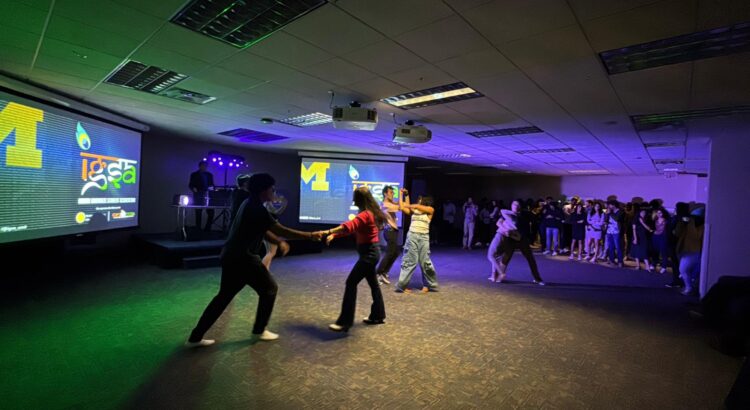The historic stage of the Michigan Theater sits sparse, except for a comfortable cyan lounge chair, a cozy floor lamp, a vintage two-knob TV, and a dainty desk with Sasha Velour’s The Big Reveal: An Illustrated Manifesto of Drag neatly atop it.
On screen behind them, a prerecorded Sasha Velour dangles a disco ball from an elegant, silver finger. As Jennifer Lopez’s Waiting for Tonight begins to play, Sasha caresses the disco ball with her other hand, and as a spotlight appears on the cyan lounge chair, the audience waits with bated breath.
In an instant, the chair blanket is yanked back to reveal…
Sasha Velour…inside the chair…and I was gagged by possibly one of the best live reveals I’ve ever seen.
Her ruby lips gleamed unobstructed through a face-sized hole, as she began to lip sync sections of Kylie Minogue’s futuristic In My Arms, Dionne Warwick’s forever cherished A House is Not a Home, and Brandy’s *perfect* rendition of In My Own Little Corner.
As the chorus of Britney Spears’ Stronger begins, Sasha sheds the chair from which she came, only to become…
Sasha Velour…the chair, again…I was gagged again.
She struts in a brocade gown of the same cyan fabric, cream tassels on her shoulders and hips, and chair arms accentuating her tightly-corseted waist…a hybridized perfection of camp, glamour, and humor on full display to close act one.
As the energy in the room quells, Sasha reflects on her grandmother Dina, who came to America from China as a Jewish immigrant during World War II and, “would always encourage me [Velour] to channel my inner diva.” Showing videos of herself as a child, Sasha cherishes these moments aloud on stage, gushing about how Dina’s love and enthusiasm shaped her as a child, and now as a performer.
In one of a series of hilarious video skits, Velour switches between various personas, who comment on drag’s significance across communities: a medium of history, of fun, of revolution. Velour asserts that drag can be anything, for anyone, and this fundamental freedom affords drag infinite power.
But what happens when this freedom is at stake? Unafraid of asking the difficult questions, Velour challenges the audience to both revel in the privilege of being able to attend her show and share in her sense of growing urgency towards collectively understanding what these next few years will bring, not just for the queer community, but for everyone the Trump administration seeks to erase.
Drag is not dangerous for children, and helps to embolden those who need creative outlets of expression… “I have always been Sasha Velour…drag has a spiritual mission to give each other the biggest gift in life — to be seen and documented as we really are…to write our own stories”. The Big Reveal is everything a drag performance should be: It acknowledges what drag has been, what it is now, and everything it can be, while somehow completely exceeding the expectations of any audience member or Sasha Velour fan in the audience.
Even if you didn’t have a chance to see Sasha Velour, supporting your local drag scene helps to contribute to the parts of her show that still sit within me as I write this — drag is more than just a performance, it is the establishment of ones’ identity in relation to themselves and their community. It is a way of surviving, thriving, and ultimately, existing in the world in a profoundly beautiful way. A way of life that has always existed, and will continue to thrive in spite of those who seek to refute it.











